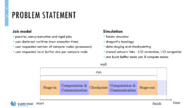 | EasyChair Smart Slide | User Guide/Log in |
| Home |

The ever-increasing gap between compute and I/O performance in HPC platforms, together with the development of novel NVMe storage devices (NVRAM), led to the emergence of the burst buffer concept—an intermediate persistent storage layer logically positioned between random-access main memory and a parallel file system. Despite the development of real-world architectures as well as research concepts, resource and job management systems, such as Slurm, provide only marginal support for scheduling jobs with burst buffer requirements, in particular ignoring burst buffers when backfilling. We investigate the impact of burst buffer reservations on the overall efficiency of online job scheduling for common algorithms: First-Come-First-Served (FCFS) and Shortest-Job-First (SJF) EASY-backfilling. We evaluate the algorithms in a detailed simulation with I/O side effects. Our results indicate that the lack of burst buffer reservations in backfilling may significantly deteriorate scheduling. We also show that these algorithms can be easily extended to support burst buffers. Finally, we propose a burst-buffer–aware plan-based scheduling algorithm with simulated annealing optimisation, which improves the mean waiting time by over 20% and mean bounded slowdown by 27% compared to the burst-buffer–aware SJF-EASY-backfilling.
















